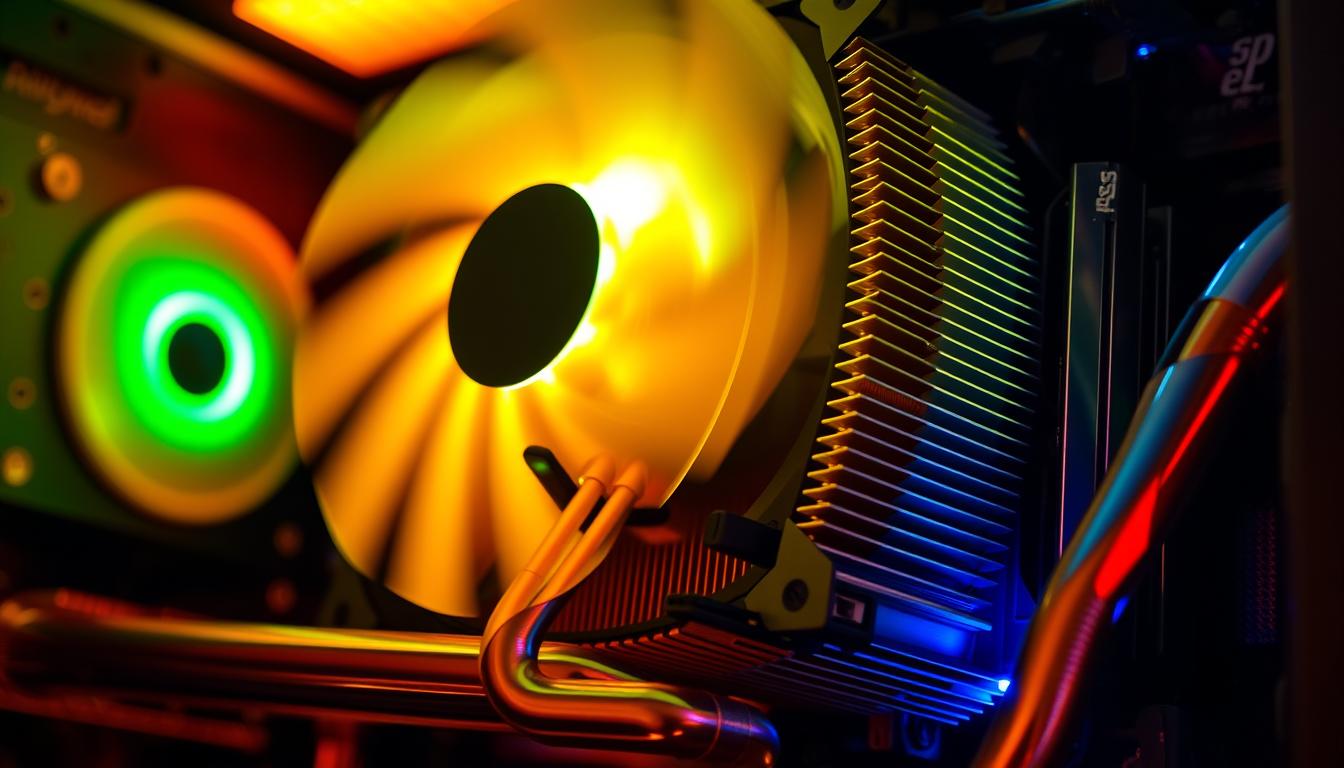Last Updated on August 7, 2025 by Gill
Gaming can be intense, pushing your computer’s limits. It’s key to watch your CPU temperature to keep your system healthy. Overheating can harm your hardware and shorten your PC’s life.
When gaming, it’s easy to forget about your computer’s stress. But, checking your CPU temperature is important. It helps your system run well, so you can play games without problems.
Knowing about CPU temperature and its effect on gaming is essential. This article will show you why CPU temperature monitoring is important. We’ll also teach you how to keep your gaming PC in top shape.
Why Monitoring CPU Temperature Matters
For gamers, keeping an eye on CPU temperature is key. It helps ensure your hardware works well and lasts longer. High temperatures can cause problems like performance drops, crashes, and even damage to the CPU.
Importance of CPU Temperature for Gaming Performance
How well your CPU runs affects your gaming. If it gets too hot, it might slow down to avoid damage. This can make your games run slower and feel less smooth. Keeping your CPU at the right temperature is vital for great gaming.
When the CPU overheats, it might lower its speed. This can hurt your system’s performance, which is a big issue during long gaming sessions. Every little bit of speed counts.
Risks of High CPU Temperatures
High CPU temperatures can lead to several issues:
- Performance throttling: The CPU slows down to avoid overheating.
- System crashes: The system might shut down suddenly due to too much heat.
- Hardware damage: Long-term exposure to high temperatures can harm the CPU.
| Temperature Range | Risks | Recommended Action |
|---|---|---|
| Below 60°C | Low risk | Monitor temperature |
| 60°C – 80°C | Moderate risk | Improve cooling |
| Above 80°C | High risk | Immediate action required |
Regular checks and keeping temperatures in check can boost your gaming and extend your hardware’s life.
Tools You Can Use to Check CPU Temperature
It’s important to keep an eye on your CPU temperature. There are many software and hardware tools to help you do this. Whether you’re into gaming or just love your PC, the right tools are key to keeping your CPU healthy and running well.
Software Solutions for Temperature Monitoring
There are many software options for checking CPU temperature. Each has its own special features and benefits. Here are some of the most popular ones:
- NZXT CAM: It’s easy to use and lets you monitor in real-time.
- Core Temp: It gives detailed temperature readings and is very customizable.
- HWMonitor: It monitors your hardware, including CPU temperature, voltage, and fan speed.
These software tools are not only good but also affordable. They’re free or very cheap, so they’re available to everyone. Here’s a quick look at what they offer:
| Software | Real-time Monitoring | Customization | Cost |
|---|---|---|---|
| NZXT CAM | Yes | High | Free |
| Core Temp | Yes | High | Free |
| HWMonitor | Yes | Medium | Free |
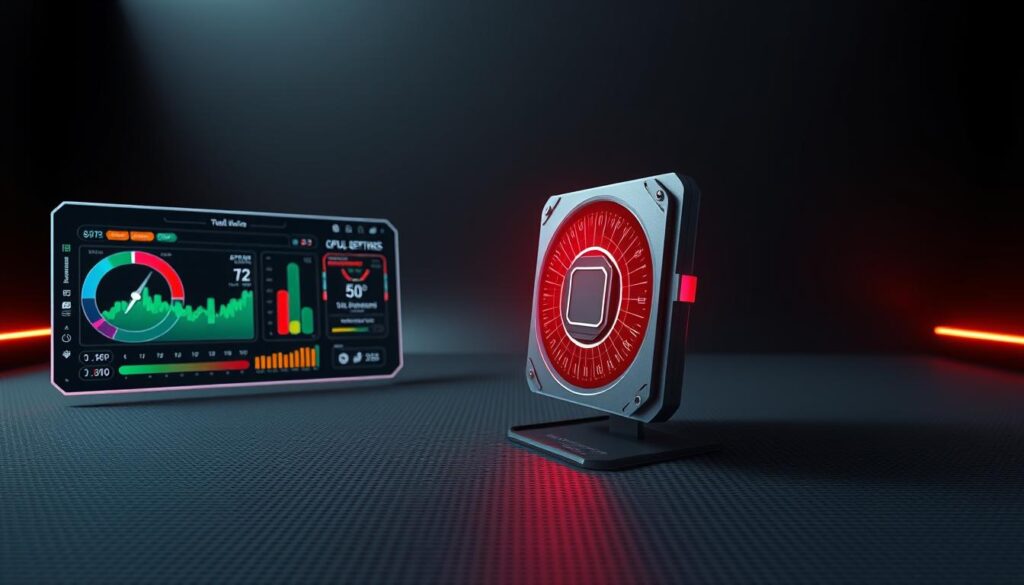
Hardware Alternatives
If you like a hands-on approach or need more accuracy, there are hardware options. These include:
- Physical Temperature Sensors: You can install them directly on the CPU or motherboard for exact temperature readings.
- Digital Thermometers: Some motherboards have built-in digital thermometers. You can access them through the BIOS or UEFI.
Hardware solutions can give you more accurate readings. They’re often used with software tools for full monitoring.
How to Use Software Tools to Monitor Temperatures
Software tools are key for checking CPU temperatures in real-time while gaming. They give you instant feedback on your CPU’s temperature. This lets you take steps to avoid overheating.
Step-by-Step Guide for Popular Monitoring Software
Using software made for monitoring is a great way to keep an eye on your CPU temperature. Core Temp is a favorite among gamers. It shows real-time temperature readings and lets you customize how it looks. In addition to its user-friendly interface, Core Temp also provides detailed information about each CPU core, making it easier for users to identify potential issues. The software supports realtime CPU temperature tracking, allowing gamers to optimize their performance during intense gaming sessions. With the ability to set temperature alerts, it ensures that your hardware stays within safe operating limits.
To use Core Temp, just follow these steps:
- Download and install Core Temp from its official website.
- Launch the app, and it will show your CPU’s temperature right away.
- You can set Core Temp to show temperatures in your taskbar for easy access.
HWMonitor is another popular choice. It gives detailed temperature readings and info on other hardware too.
| Software | Real-time Temperature Readings | Customizable Display |
|---|---|---|
| Core Temp | Yes | Yes |
| HWMonitor | Yes | Limited |
Interpreting Your CPU Temperature Readings
It’s important to know what your CPU temperature readings mean. A temperature under 80°C (176°F) is usually safe for gaming. But, if it goes over 90°C (194°F), it might be a sign of a problem.
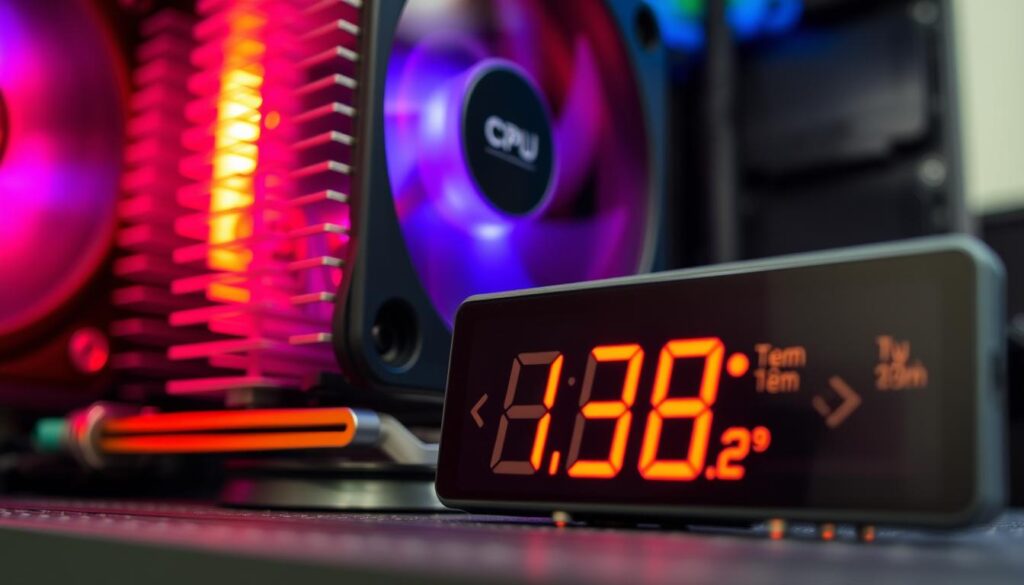
If your CPU temperature stays high, it’s time to think about better cooling or less work for your CPU. Checking your CPU temperature often can help spot issues early.
Setting Up Hardware Monitoring Tools
Monitoring your CPU’s temperature is key for gamers and PC fans. It helps keep your system running smoothly and lasts longer.
Installing a Physical Temperature Sensor
Installing a physical temperature sensor is a great way to track CPU temperature. These sensors attach to the CPU or nearby to give precise readings. Pick one that fits your system and needs.
Steps for Installation:
- Choose a sensor that matches your CPU.
- Follow the maker’s guide to attach the sensor to the CPU or nearby.
- Link the sensor to your monitoring setup, like a hardware monitor or motherboard.
Using BIOS/UEFI for Temperature Checks
Modern motherboards let you check CPU temps in BIOS or UEFI. It’s a simple way to monitor without extra software.
How to Use BIOS/UEFI for Temperature Monitoring:
- Restart and enter BIOS/UEFI settings (usually by pressing F2, F12, or DEL).
- Go to the hardware monitoring section for CPU temperature.
- Record the temperature and compare it to your CPU’s normal range.
Here’s a look at different ways to check CPU temperature:
| Method | Accuracy | Ease of Use |
|---|---|---|
| Physical Temperature Sensor | High | Moderate |
| BIOS/UEFI Monitoring | High | Easy |
| Software Monitoring Tools | Variable | Easy |
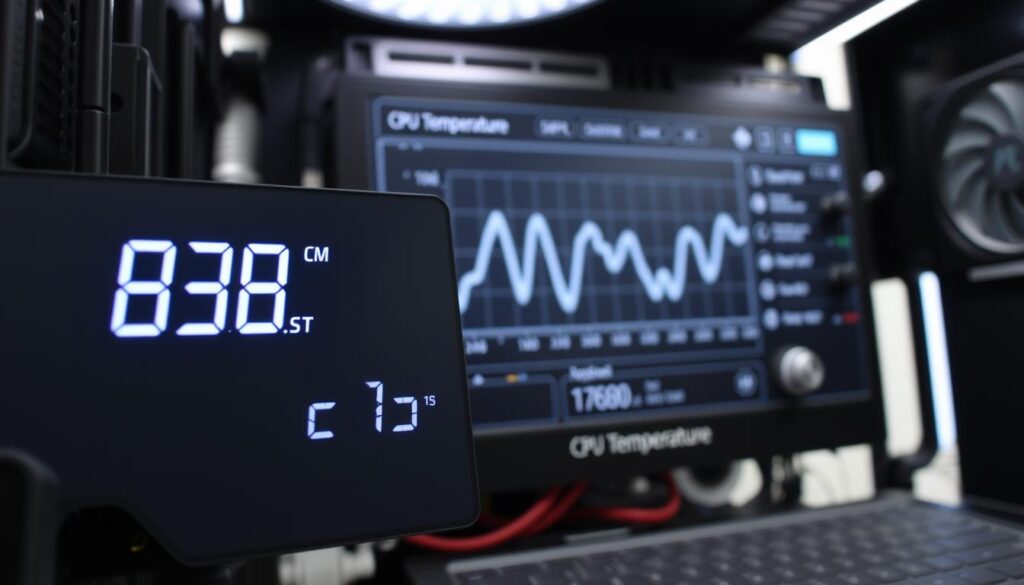
Using hardware monitoring tools helps you understand your CPU’s temperature. This way, you can keep your system running well and avoid overheating.
Optimal CPU Temperature Ranges While Gaming
Knowing the best CPU temperature range is vital to avoid overheating while gaming. CPU temperatures should stay under 80°C during intense gaming.
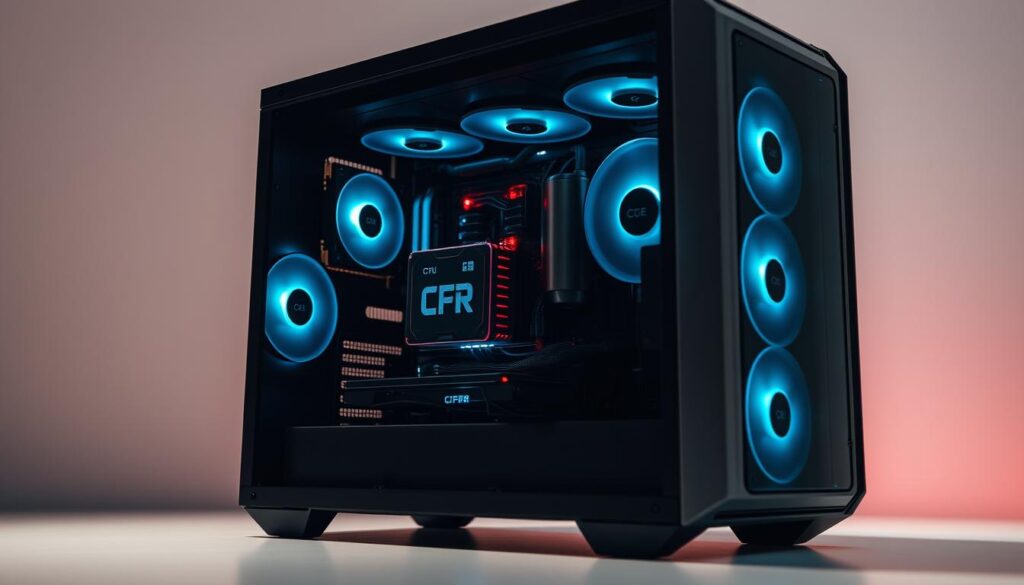
Keeping it below 80°C helps your CPU work well without slowing down or shutting off due to heat.
Understanding Normal vs. High Temperatures
Normal CPU temperatures are between 60°C to 70°C when under load. But, this can change based on the CPU model and cooling. Temperatures over 80°C are high and can make your CPU work less efficiently.
High temperatures might come from bad cooling, dust, or overclocking without cooling. It’s important to watch your CPU temperature to see if it’s safe.
Tips for Keeping Your CPU Cool
To keep your CPU cool, make sure your PC case has good airflow. Use enough case fans and make sure your CPU cooler works well. Regular cleaning of dust from the cooler and fans is also key.
- Choose a high-quality CPU cooler that fits your CPU.
- Apply the right thermal paste between the CPU and cooler.
- Make sure your PC case has good airflow.
- Keep an eye on your CPU temperatures, mainly during gaming.
By following these tips, you can keep your CPU at the right temperature. This will improve your gaming and help your CPU last longer.
Signs Your CPU Is Overheating
It’s important to know when your CPU is overheating. This can harm your computer’s health and performance. Overheating can mess up your gaming and make your system less reliable.
Recognizing Performance Issues
A drop in performance is a key sign of CPU overheating. When it gets too hot, your CPU might slow down to avoid damage. This can make games run slower, responses slower, and apps feel sluggish.
If your system feels slow, it might be overheating. This is more noticeable when you’re doing something that uses a lot of resources, like gaming.
Identifying System Crashes or Freezes
System crashes or freezes are another sign of CPU overheating. When it gets too hot, your system might shut down or freeze to protect itself. You might see:
| Symptom | Description |
|---|---|
| Blue Screen of Death (BSOD) | A Windows system crash that can be caused by overheating |
| System Freezes | The system becomes unresponsive and requires a manual restart |
| Random Reboots | The system restarts without warning, potentially due to overheating |
If you’re seeing these problems, check your CPU temperature. Taking steps to cool it down is key. Regular checks and maintenance can keep your CPU safe and your system running well.
Best Practices for Maintaining Optimal CPU Temperature
To keep your CPU running smoothly during gaming, follow key temperature maintenance practices. Keeping your CPU at the right temperature is vital for both performance and hardware longevity.
Cleaning Your PC and Improving Airflow
Cleaning your PC regularly can greatly improve airflow and lower temperatures. It’s wise to clean your PC every few months. If you see a lot of dust, you might need to do it more often.
Steps to Improve Airflow:
- Make sure your PC is in a well-ventilated spot.
- Choose high-quality fans for better airflow.
- Think about getting a liquid cooling system for better heat management.
Overclocking Safely: What You Need to Know
Overclocking can make your CPU perform better, but it’s risky if not done right. Monitoring your CPU temperature is key when overclocking.
Safe Overclocking Practices:
- Start with small increases in clock speed and watch the temperature.
- Use software to stress test your CPU and check stability.
- Make sure your cooling system can handle the extra heat.
By sticking to these practices, you can boost your gaming performance safely. This keeps your CPU at a safe temperature.
Conclusion: Keeping Your CPU in Check While Gaming
Keeping your CPU cool is key for gamers who want the best performance. It helps avoid overheating. By watching your CPU’s temperature, you can keep your system healthy.
Effective Monitoring Strategies
Use good software or hardware to watch your CPU’s temperature live. Checking it often helps spot problems early. This way, you can fix them before they get worse.
Staying on Top of Temperature Checks
Make it a habit to check your CPU’s temperature while gaming. This keeps your system running well. It makes your games better. Adding CPU checks to your gaming routine is vital for top performance.
- RTX 3070 Bottleneck Calculator: Optimize Your Setup - September 27, 2025
- Optimize Your RTX 3060 Ti: Use Our Bottleneck Calculator - September 26, 2025
- GeForce RTX 5060 Bottleneck Calculator – Find Your GPU’s Limits - September 25, 2025

